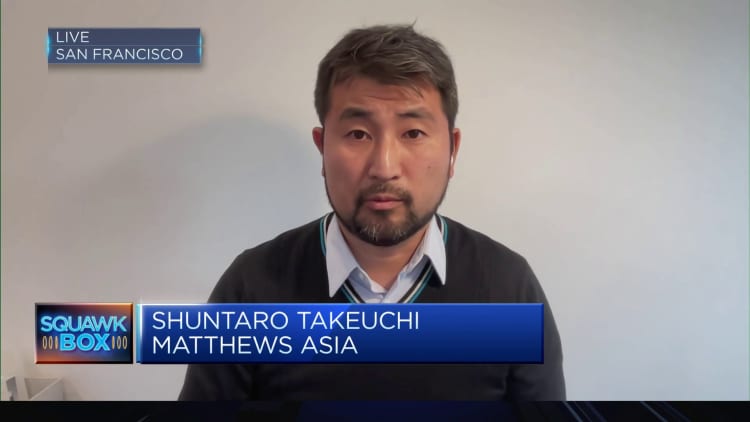Japan bar chart graph with ups and downs, growing values, idea of financial restoration and enterprise bettering, companies reopen, politics idea with flag
Elif Bayraktar | Istock | Getty Photographs
Hypothesis is swirling that the Financial institution of Japan could transfer to exit the world’s final damaging price coverage as early as subsequent week, when policymakers collect for his or her March assembly.
To be clear, most analysts anticipate Japan’s first price hike since 2007 to happen in April after policymakers have extra proof of a significant wage improve following the “shunto” annual spring negotiations between unions and employers later this week.
“We proceed to anticipate that the BOJ will terminate NIRP in April,” Goldman Sachs economists led by Tomohiro Ota wrote in a Tuesday notice, referring to the damaging rate of interest coverage. “Whereas a March price hike can’t be dominated out, we consider that the BOJ’s communications at this juncture usually are not clear sufficient to justify assuming the March hike as the bottom case situation.”
“By suspending the speed hike determination only for a month, the BOJ can acquire extra information, can receive a possibility to clarify their views behind the foremost coverage change by way of the quarterly Financial Outlook report, and might keep away from a price hike simply earlier than fiscal 12 months finish when many monetary establishments shut their books,” they added.
Whereas BOJ Governor Kazuo Ueda meets along with his different eight board members eight instances a 12 months, the central financial institution updates its financial outlook solely 4 instances: in January, April, July and October. The BOJ’s subsequent assembly is March 18-19.
Regardless of “core core inflation” — which excludes meals and vitality costs — exceeding its 2% goal for greater than a 12 months, the BOJ has barely budged from its present ultra-accommodative financial coverage posture that has been in place in 2016.
Whereas the central financial institution has successfully loosened its yield curve management coverage over long term rates of interest over the previous 16 months, it has saved rates of interest at -0.1% and nonetheless maintains an higher restrict for 10-year Japanese authorities bond yield at 1% as a reference.
The yield curve management is a coverage software the place the BOJ targets an rate of interest, after which buys and sells bonds as obligatory to attain that focus on.
Apart from the YCC, Japan has additionally engaged in unconventional coverage experimentation for many years with asset shopping for and quantitative easing in its bid to elevate the world’s fourth-largest economic system out of deflation.
“The Financial institution of Japan has no proper to maintain financial coverage the place [they are now]. The economic system isn’t in any form or kind to have that ultra-loose financial coverage and quantitative easing, which now we have been calling a serious coverage error,” Amir Anvarzadeh, a market strategist at Uneven Advisors, instructed CNBC Tuesday.
Japan, now the world’s fourth-largest economic system, narrowly prevented a technical recession in revised GDP print launched Monday, which confirmed personal consumption contracted for a 3rd quarter in a row.
Inflation blues
Excessive inflation is crimping home demand and personal consumption, underscoring the fragility of progress in Japan. Non-public consumption fell 0.3% quarter on quarter — greater than the provisional estimates of a 0.2% decline, in keeping with the ultimate GDP information launched Monday.
In reality, it was largely attributable to energy in capital expenditure that Japan managed to avert a technical recession. Nonetheless, upward revisions have been weaker than anticipated.
“Inflation in Japan is being underestimated,” mentioned Anvarzadeh, including that authorities subsidies — which tentatively expire in April — have saved inflation “artificially low.”
“However as soon as they do expire, inflation will likely be even larger,” he added.
Ueda has repeatedly indicated imported price pressures from excessive vitality costs within the post-Covid interval have been probably driving worth will increase in Japan, and he’s searching for proof of natural price pressures.
The central financial institution believes wage increments would translate right into a extra significant spiral, encouraging customers to spend.
“Value-push inflation is inflation, no matter what you may suppose. What do you suppose it is all over the place else?” mentioned Anvarzadeh. “The massive fallacy is that within the final 20 years, it was that deflation that harm consumption.”
“Really, deflation helped consumption in Japan as a result of wages have been stagnating, costs have been falling and thus, consumption held up. And now, wages are going up, and now inflation’s nonetheless rising forward of that and consumption has been harm,” he added.
Market repositioning
After some latest hawkish feedback from BOJ officers, Japan narrowly averting a technical recession and hopes rising for strong wage features, some market repositioning has kicked into gear as traders brace themselves for a attainable BOJ transfer in March.
Financial institution of America’s economists on Tuesday introduced ahead their base case for a BOJ damaging price exit at subsequent week’s assembly, as a substitute of their earlier forecast for April — underscoring the widening schism in market views.

The rally in Japanese equities has grounded to a halt, with the yen strengthening towards the greenback and 10-year Japanese authorities bond yields hitting their highest in three months Tuesday.
BOJ governor Ueda appeared to mood expectations Tuesday, placing a comparatively extra pessimistic tone on the Japanese economic system than two months in the past in feedback to Japan’s parliament.
Additionally Tuesday, Finance Minister Shunichi Suzuki mentioned Japan was not at a stage the place it might declare deflation as crushed, Reuters reported.
‘Time is correct for wage improve’
Shunto wage negotiations will end Wednesday, with the primary tally of negotiated outcomes out there from Friday. Japan’s greatest commerce union grouping Rengo mentioned staff at main corporations have requested for annual will increase of 5.85%, exceeding the 5% degree for the primary time in three a long time.
If that’s the case, that might prime the greater than 3% will increase achieved final 12 months, which have been the largest improve in about three a long time.

“In comparison with different years, [they are] far more open by way of elevated wages… as a result of over the previous decade, what’s noticeable is that company Japan has been raking up earnings and the revenue margins are already at file excessive ranges and on prime of that, with the scarcity of labor itself, the time is correct for wage improve,” Shuntaro Takeuchi, a Japan fund supervisor at Matthews Asia, instructed CNBC Wednesday.
“This 12 months, many of the corporates — a variety of the corporates — are beginning to really announce extra wage hikes even larger than [5%], based mostly on some sectors. I believe they’re extra proactive than final 12 months, so I would not be stunned if it lands someplace between 3% and 5%,” he added.
What would an exit appear to be?
Many market contributors are trying past the timing of BOJ’s coverage change.
“BOJ Governor Ueda mentioned on the press convention after the January [monetary policy meeting] that the financial coverage atmosphere will stay extraordinarily simple in the intervening time, implying that subsequent price hikes could be very modest,” Goldman Sachs economists mentioned.

“Whether or not the BOJ mentions the longer term path within the coverage assertion in a bid to restrict extreme price hike expectations and accompanying danger of rate of interest rises, or whether or not it’ll solely use ambiguous language to be able to prioritize flexibility in coverage to deal with inflation dangers sooner or later will likely be essential to gauge the order of the BOJ’s financial coverage priorities,” they added.
Reuters reported that if the BOJ exits damaging charges, it’ll additionally probably abandon the yield curve management coverage that guides the 10-year Japanese authorities bond yield at round 0% with a cap at 1%.
As an alternative, the Japanese central financial institution will probably provide numerical steerage on how a lot authorities bonds it’ll buy to keep away from inflicting market disruption, Reuters reported, citing sources conversant in the matter.

